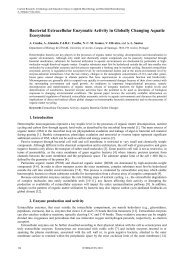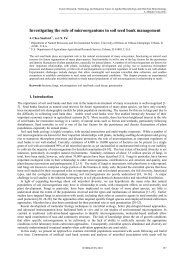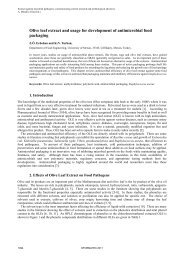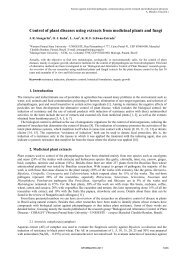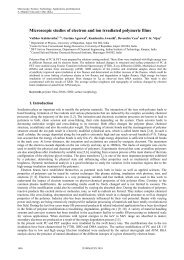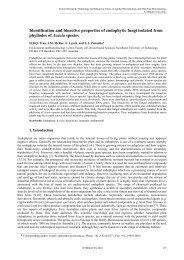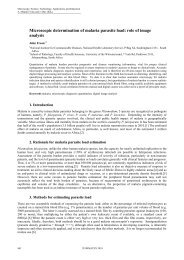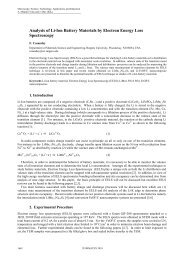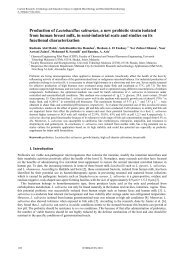Contribution of microscopy to the study of proliferating blood cells in ...
Contribution of microscopy to the study of proliferating blood cells in ...
Contribution of microscopy to the study of proliferating blood cells in ...
You also want an ePaper? Increase the reach of your titles
YUMPU automatically turns print PDFs into web optimized ePapers that Google loves.
<strong>Contribution</strong> <strong>of</strong> <strong>microscopy</strong> <strong>to</strong> <strong>the</strong> <strong>study</strong> <strong>of</strong> <strong>proliferat<strong>in</strong>g</strong> <strong>blood</strong> <strong>cells</strong> <strong>in</strong><br />
Ciona <strong>in</strong>test<strong>in</strong>alis immune response<br />
M. A. Di Bella and G. De Leo<br />
Department <strong>of</strong> Biopa<strong>to</strong>logia e Biotecnologie Mediche e Forensi, University <strong>of</strong> Palermo, Via Divisi 83, 90133, Palermo,<br />
Italy<br />
Follow<strong>in</strong>g an <strong>in</strong>flamma<strong>to</strong>ry stimulus such as <strong>the</strong> <strong>in</strong>jection <strong>of</strong> erythrocytes <strong>in</strong><strong>to</strong> <strong>the</strong> tunic <strong>of</strong> Ciona <strong>in</strong>test<strong>in</strong>alis, hemocytes<br />
respond <strong>to</strong> events occurr<strong>in</strong>g <strong>in</strong> <strong>the</strong> tunic with<strong>in</strong> a short time, and <strong>in</strong>filtrate <strong>the</strong> <strong>in</strong>flamed tissue be<strong>in</strong>g massively <strong>in</strong>volved <strong>in</strong><br />
<strong>the</strong> acute <strong>in</strong>flamma<strong>to</strong>ry response and capsule formation.<br />
The proliferative response <strong>of</strong> circulat<strong>in</strong>g hemocytes and pharynx assume particular <strong>in</strong>terest as it is significantly enhanced<br />
dur<strong>in</strong>g <strong>the</strong>se defence reactions. Microscopy clearly may contribute <strong>to</strong> extend our understand<strong>in</strong>g <strong>of</strong> <strong>the</strong> phenomenon<br />
show<strong>in</strong>g <strong>in</strong>terest<strong>in</strong>g mi<strong>to</strong>tic figures and hema<strong>to</strong>genic nodules with proliferative characteristics.<br />
Keywords: Ciona <strong>in</strong>test<strong>in</strong>alis; ascidians; cell proliferation; ultrastructure<br />
1. Introduction<br />
Ascidians, known as sea squirt, are cosmopolitan <strong>in</strong>vertebrates that occupy a key phylogenetic position because <strong>the</strong>y are<br />
considered a sister group <strong>of</strong> vertebrates be<strong>in</strong>g classified <strong>in</strong> <strong>the</strong> phylum Chordata, subphylum Urochordata [1]. Ow<strong>in</strong>g <strong>to</strong><br />
<strong>the</strong>ir position <strong>the</strong>y have acquired importance <strong>in</strong> immunity evolution studies, and Ciona <strong>in</strong>test<strong>in</strong>alis, a reference species<br />
<strong>of</strong> <strong>the</strong> solitary ascidians, is a valuable model organism for <strong>the</strong> <strong>study</strong> <strong>of</strong> a variety <strong>of</strong> biological processes.<br />
In <strong>the</strong> presence <strong>of</strong> pathogens or foreign material <strong>in</strong>jected <strong>in</strong><strong>to</strong> <strong>the</strong> body wall, C. <strong>in</strong>test<strong>in</strong>alis displays acute<br />
<strong>in</strong>flamma<strong>to</strong>ry responses consist<strong>in</strong>g <strong>in</strong> humoral and cellular reactions performed by <strong>blood</strong> <strong>cells</strong>. Hemocytes are essential<br />
for recognition <strong>of</strong> self and non-self, for phagocy<strong>to</strong>sis, encapsulation and lysis <strong>of</strong> foreign agents, and repair <strong>of</strong> damaged<br />
tissue. In a few hours <strong>the</strong> <strong>in</strong>flamed tissue appears densely populated with hemocytes that, com<strong>in</strong>g from <strong>the</strong> <strong>blood</strong><br />
lacunae, <strong>in</strong>s<strong>in</strong>uate <strong>the</strong>mselves <strong>in</strong><strong>to</strong> <strong>the</strong> <strong>in</strong>tercellular spaces and cross <strong>the</strong> epidermis contribut<strong>in</strong>g <strong>to</strong> <strong>the</strong> capsule formation<br />
[2-7]. In this sense, circulat<strong>in</strong>g hemocytes, com<strong>in</strong>g from <strong>the</strong> hemolymph, phar<strong>in</strong>x, and hema<strong>to</strong>genic sites, assume<br />
particular <strong>in</strong>terest.<br />
In C. <strong>in</strong>test<strong>in</strong>alis several hemocyte types have been described [8], and among <strong>the</strong>m, hemoblasts or stem <strong>cells</strong> are<br />
considered able <strong>to</strong> proliferate and/or differentiate diverse hemocyte types also <strong>in</strong> o<strong>the</strong>r ascidian species [9].<br />
The ultrastructural observations reported <strong>in</strong> <strong>the</strong> present <strong>study</strong> re<strong>in</strong>force <strong>the</strong> view that after <strong>the</strong> <strong>in</strong>flamma<strong>to</strong>ry stimulus,<br />
<strong>the</strong> hemoblasts <strong>in</strong> <strong>blood</strong> lacunae and hema<strong>to</strong>genic nodules may undergo an <strong>in</strong>creased proliferative activity.<br />
2. Material and Methods<br />
C. <strong>in</strong>test<strong>in</strong>alis specimens about 10-12 cm long were collected from Palermo harbour. Animals free <strong>of</strong> encrust<strong>in</strong>g mar<strong>in</strong>e<br />
matter were ma<strong>in</strong>ta<strong>in</strong>ed at 15-18°C <strong>in</strong> aerated sea water. Sheep erythrocytes (1 x 10 7 suspended <strong>in</strong> 0.2 ml phosphatebuffered<br />
sal<strong>in</strong>e solution, pH 7.4) were <strong>in</strong>jected <strong>in</strong><strong>to</strong> <strong>the</strong> tunic [3]. Four days later, <strong>the</strong> specimens show<strong>in</strong>g tunic reaction<br />
were isolated. Ciona specimens <strong>in</strong>jected with 0.2 ml phosphate buffered sal<strong>in</strong>e solution (PBS) served as controls. Cubes<br />
<strong>of</strong> <strong>the</strong> <strong>in</strong>jected region, 1 <strong>to</strong> 3 mm long, were fixed us<strong>in</strong>g <strong>the</strong> follow<strong>in</strong>g procedure.<br />
They were placed for 1 hr at 4 °C <strong>in</strong> a solution conta<strong>in</strong><strong>in</strong>g 1.5% glutaraldehyde, buffered with 0.05 M sodium<br />
cacodylate (pH 7.3 plus 1.7% sodium chloride). After brief r<strong>in</strong>s<strong>in</strong>g, <strong>the</strong>y were postfixed for 1hr at 4 °C with 1% osmium<br />
tetroxide <strong>in</strong> 0.05 M sodium cacodylate at pH 7.3<br />
All specimens were r<strong>in</strong>sed briefly and dehydrated <strong>in</strong> a graded series <strong>of</strong> ethanol solutions, cleared <strong>in</strong> propylene oxide<br />
and embedded <strong>in</strong> Epon res<strong>in</strong>. Th<strong>in</strong> sections were sta<strong>in</strong>ed with uranyl acetate and lead citrate and exam<strong>in</strong>ed under a<br />
transmission electron microscope (Philips CM 10), at 80 kV.<br />
3. Results<br />
Microscopy: Science, Technology, Applications and Education<br />
______________________________________________<br />
A. Méndez-Vilas and J. Díaz (Eds.)<br />
After an experimental <strong>in</strong>jury, <strong>the</strong> pharyngeal areas <strong>of</strong> C. <strong>in</strong>test<strong>in</strong>alis were studied <strong>in</strong> selected th<strong>in</strong> sections at EM. The<br />
body wall <strong>of</strong> a tunicate consists <strong>of</strong> two epi<strong>the</strong>lial sheets; <strong>the</strong> outer is <strong>the</strong> epidermis covered with <strong>the</strong> tunic, and <strong>the</strong> <strong>in</strong>ner<br />
is <strong>the</strong> atrial epi<strong>the</strong>lium that encircles <strong>the</strong> phar<strong>in</strong>x: between <strong>the</strong>se two sheets <strong>the</strong>re are mesenchymal <strong>cells</strong> that move<br />
freely.<br />
©FORMATEX 2010 111
Microscopy: Science, Technology, Applications and Education<br />
A. ______________________________________________<br />
Méndez-Vilas and J. Díaz (Eds.)<br />
Fig. 1. Electron micrograph at low magnification <strong>of</strong> vessel<br />
endo<strong>the</strong>lium and a nodular portion <strong>of</strong> it. Cells <strong>of</strong> <strong>the</strong> s<strong>in</strong>gle<br />
layer are flat, a free <strong>blood</strong> cell <strong>in</strong> <strong>the</strong> lumen can be observed.<br />
Cells <strong>in</strong> <strong>the</strong> nodule are closely packed, some <strong>of</strong> <strong>the</strong>m are<br />
columnar <strong>in</strong> shape; nuclei are large and sometimes conta<strong>in</strong><br />
two nucleoli (box). L= lumen; en= endo<strong>the</strong>lium.<br />
Magnification: 2 600x.<br />
In <strong>the</strong> pharyngeal wall <strong>of</strong> C. <strong>in</strong>test<strong>in</strong>alis hemolymphatic lacunae and hema<strong>to</strong>genic tissue or lymph nodules occur.<br />
Lymph nodules that lie below <strong>the</strong> atrial epi<strong>the</strong>lium and along <strong>the</strong> <strong>blood</strong> channel have been observed as small ansae or<br />
projections with a nodular appearance. The usual arrangement <strong>of</strong> <strong>the</strong> atrial epi<strong>the</strong>lium and vessel endo<strong>the</strong>lium is that <strong>of</strong><br />
a s<strong>in</strong>gle layer <strong>of</strong> flattened <strong>cells</strong> with a regular pr<strong>of</strong>ile on <strong>the</strong> side <strong>of</strong> <strong>the</strong> lumen on <strong>the</strong> basal lam<strong>in</strong>a. In Figure 1 we<br />
observe <strong>the</strong> <strong>cells</strong> <strong>of</strong> <strong>the</strong> nodule that are arranged <strong>in</strong> layers; <strong>the</strong>y <strong>of</strong>ten thicken and assume a polygonal shape; cell<br />
boundaries <strong>in</strong>terdigited with each o<strong>the</strong>r; some laterally placed <strong>cells</strong> are columnar and present elongated cilia project<strong>in</strong>g<br />
<strong>in</strong><strong>to</strong> <strong>the</strong> atrial cavity. These <strong>cells</strong> <strong>in</strong> <strong>the</strong> nodule conta<strong>in</strong> a nucleus with one or two nucleoli, and some mi<strong>to</strong>chondria; <strong>the</strong>y<br />
are rich <strong>in</strong> free ribosomes, all features that reflect an undifferentiated state.<br />
Fig. 2. Group <strong>of</strong> <strong>cells</strong> with <strong>the</strong> feature <strong>of</strong> hemoblasts are seen adjacent <strong>to</strong> <strong>the</strong> atrial epi<strong>the</strong>lium (ae). Cells border directly one on<br />
ano<strong>the</strong>r, giv<strong>in</strong>g angular outl<strong>in</strong>es. Nucleus is spherical, conta<strong>in</strong><strong>in</strong>g nucleolus <strong>of</strong>ten adjacent <strong>to</strong> <strong>the</strong> nuclear membrane (Fig. 2c). The<br />
cy<strong>to</strong>plasm essentially granular conta<strong>in</strong>s round or oval mi<strong>to</strong>chondrial pr<strong>of</strong>iles. Note <strong>the</strong> atrial epi<strong>the</strong>lium with a basement membrane<br />
fac<strong>in</strong>g <strong>the</strong> cellular aggregates. Some epi<strong>the</strong>lial <strong>cells</strong> protrude <strong>in</strong><strong>to</strong> <strong>the</strong> lumen and seem <strong>to</strong> surround <strong>the</strong> <strong>blood</strong> <strong>cells</strong>. In <strong>the</strong> peripheral<br />
marg<strong>in</strong> <strong>of</strong> <strong>the</strong> nodule some <strong>cells</strong> still show po<strong>in</strong>ts <strong>of</strong> close membrane apposition while o<strong>the</strong>r <strong>cells</strong> are free <strong>in</strong> <strong>the</strong> lumen. Matur<strong>in</strong>g<br />
<strong>cells</strong> have dense granules <strong>in</strong> <strong>the</strong> cy<strong>to</strong>plasm some <strong>of</strong> which are very large (Fig. 2b). In <strong>the</strong> Fig. 2d a hemoblast cell with large nucleus<br />
and tubular cisternae <strong>of</strong> RER <strong>in</strong> <strong>the</strong> cy<strong>to</strong>plasm. L= lumen. Magnification: (a) 3 200x; (b) 2 100x; (c) 5 250x; (d) 5 250x.<br />
In Figure 2 patches <strong>of</strong> <strong>cells</strong>, most <strong>of</strong> which resemble hemoblasts as <strong>the</strong>y do not show any specialized features, can be<br />
observed; <strong>the</strong>y occur more <strong>of</strong>ten than usual, and immediately adjacent <strong>to</strong> <strong>the</strong> atrial epi<strong>the</strong>lium. Cells present <strong>in</strong> each<br />
112 ©FORMATEX 2010
Microscopy: Science, Technology, Applications and Education<br />
______________________________________________<br />
A. Méndez-Vilas and J. Díaz (Eds.)<br />
group show a relatively simple structure, be<strong>in</strong>g characterized by a spherical <strong>to</strong> oval nucleus which occupies a large<br />
portion <strong>of</strong> <strong>the</strong> cy<strong>to</strong>plasm and may conta<strong>in</strong> prom<strong>in</strong>ent nucleoli adjacent <strong>to</strong> <strong>the</strong> nuclear membrane. The cy<strong>to</strong>plasm is rich<br />
<strong>in</strong> free ribosomes, and sometimes conta<strong>in</strong>s some elongated or tubular cisternae <strong>of</strong> RER, and mi<strong>to</strong>chondria. A lot <strong>of</strong> <strong>cells</strong><br />
are <strong>of</strong>ten closely packed so that cell boundaries are difficult <strong>to</strong> dist<strong>in</strong>guish as membranes <strong>of</strong> adjacent <strong>cells</strong> may be<br />
completely adherent or with a th<strong>in</strong> <strong>in</strong>tercellular space, and <strong>the</strong>ir shape <strong>of</strong>ten appears irregular (Fig. 2c). On <strong>the</strong><br />
peripheral marg<strong>in</strong> <strong>of</strong> <strong>the</strong> clusters, <strong>the</strong> <strong>cells</strong> are less packed because <strong>the</strong> <strong>in</strong>tercellular spaces become larger and more<br />
irregular until <strong>the</strong> <strong>cells</strong> detach from <strong>the</strong> group and become free <strong>in</strong> <strong>the</strong> lacunae. In <strong>the</strong>se areas matur<strong>in</strong>g <strong>blood</strong> <strong>cells</strong> can be<br />
observed. Fig. 2b show some <strong>of</strong> <strong>the</strong>m lack<strong>in</strong>g <strong>the</strong> nucleus and characterized by <strong>the</strong> presence <strong>of</strong> electron dense granules.<br />
The granules may become very large and vesicles can also be seen <strong>in</strong> <strong>the</strong> cy<strong>to</strong>plasm.<br />
Fig 3. Micrograph <strong>of</strong> free hemocytes <strong>in</strong> <strong>blood</strong> lacunae. (a) Group <strong>of</strong> hemocytes where a hemoblast-like cell is surrounded by<br />
differentiated <strong>blood</strong> <strong>cells</strong>. The hemoblast (arrow) present a large nucleus with evident nuclear membrane and pores; cy<strong>to</strong>plasm lacks<br />
organelles. The differentiated <strong>cells</strong> are granulocyte types, <strong>the</strong>y present a unique granule that nearly occupies <strong>the</strong> whole cell except at<br />
<strong>the</strong> edge where numerous vesicles can be seen. (b) A group <strong>of</strong> <strong>cells</strong> <strong>in</strong>terconnected with two <strong>in</strong>tercellular bridges. Cells are spherical<br />
with a large round nucleus and nucleolus. Cy<strong>to</strong>plasm conta<strong>in</strong>s numerous polyribosomes and rare long cisternae <strong>of</strong> RER; few<br />
mi<strong>to</strong>chondria and a Golgi complex are observed. Note <strong>the</strong> smallest cell where <strong>the</strong> nuclear membrane is not clearly dist<strong>in</strong>guishable.<br />
(c) Detail <strong>of</strong> <strong>the</strong> <strong>in</strong>tercellular bridges. The bridges are cyl<strong>in</strong>drically shaped, and consist <strong>of</strong> a thicken<strong>in</strong>g <strong>of</strong> <strong>the</strong> plasma membrane. The<br />
region <strong>of</strong> cy<strong>to</strong>plasmic cont<strong>in</strong>uity between <strong>cells</strong> conta<strong>in</strong>s ribosomes and near it RER elongated cisternae appear (arrow head). en:<br />
endo<strong>the</strong>lium. Magnification: (a) 4 400x; (b) 5 500x; (c) 18 200x.<br />
Figure 3 shows <strong>cells</strong> characterized by ultrastructural features and nucleus/cy<strong>to</strong>plasm ratio <strong>of</strong> undifferentiated<br />
elements found <strong>in</strong> <strong>the</strong> circulat<strong>in</strong>g hemolimph. These <strong>cells</strong> previously morphologically described as hemoblast or<br />
hemoblast-like <strong>cells</strong> [8] are frequently surrounded by o<strong>the</strong>r differentiated <strong>blood</strong> <strong>cells</strong> (Fig3a). This f<strong>in</strong>d<strong>in</strong>g agrees with<br />
<strong>the</strong> role proposed for hemoblast as a source <strong>of</strong> o<strong>the</strong>r <strong>blood</strong> cell types.<br />
Cells show a round con<strong>to</strong>ur, <strong>the</strong>ir surface is smooth and <strong>the</strong>y measure approximately 5µm <strong>in</strong> diameter. They show a<br />
large roundish nucleus with an essentially granular nucleolus and nuclear membrane with pores. The cy<strong>to</strong>plasm is<br />
©FORMATEX 2010 113
Microscopy: Science, Technology, Applications and Education<br />
A. ______________________________________________<br />
Méndez-Vilas and J. Díaz (Eds.)<br />
homogenously gra<strong>in</strong>y, conta<strong>in</strong><strong>in</strong>g few roundish mi<strong>to</strong>chondria and a Golgi complex. Most <strong>of</strong> <strong>the</strong> cy<strong>to</strong>plasm is filled with<br />
numerous polyribosomes, but some RER cisternae can also be observed; occasionally RER narrow pr<strong>of</strong>iles run through<br />
<strong>the</strong> cy<strong>to</strong>plasm.<br />
Surpris<strong>in</strong>gly <strong>the</strong> most prom<strong>in</strong>ent feature <strong>of</strong> <strong>the</strong>se circulat<strong>in</strong>g <strong>blood</strong> <strong>cells</strong> is <strong>the</strong> presence <strong>of</strong> <strong>in</strong>tercellular bridges. Three<br />
or more <strong>cells</strong> are <strong>in</strong> fact l<strong>in</strong>ked by bridges, thus <strong>the</strong>re is a cy<strong>to</strong>plasmic cont<strong>in</strong>uity among <strong>the</strong>m. In Figures 3b and c <strong>the</strong><br />
connect<strong>in</strong>g <strong>in</strong>tercellular bridges are shown; <strong>the</strong>y have a cyl<strong>in</strong>drical shape and a diameter <strong>of</strong> 0.3 µm. A local thicken<strong>in</strong>g<br />
<strong>of</strong> <strong>the</strong> membrane surround<strong>in</strong>g <strong>the</strong> bridge can be evidenced so that <strong>the</strong> rim appears more electron-dense than <strong>the</strong> rest <strong>of</strong><br />
<strong>the</strong> surface membrane. Near <strong>the</strong> bridges some RER cisternae occur.<br />
4. Discussion<br />
In <strong>the</strong> absence <strong>of</strong> vertebrate-like adaptive immunity, <strong>the</strong> defence responses <strong>of</strong> <strong>in</strong>vertebrates are ma<strong>in</strong>ly based on<br />
humoral fac<strong>to</strong>rs and cellular activities. In tunicates <strong>in</strong>flamma<strong>to</strong>ry responses as well as <strong>in</strong>flamma<strong>to</strong>ry events l<strong>in</strong>ked <strong>to</strong><br />
allorecognition responses both share <strong>the</strong> <strong>in</strong>volvement <strong>of</strong> hemocytes [3, 10, 11]. Hemocytes <strong>of</strong>ten migrate from <strong>the</strong><br />
hemocoel or tunic vessel <strong>in</strong><strong>to</strong> <strong>the</strong> tunic <strong>in</strong> response <strong>to</strong> <strong>in</strong>jury, or o<strong>the</strong>r events, likely mediated by chemotactic cues [12,<br />
13] and <strong>the</strong>y are likely provided with a complex <strong>of</strong> surface recep<strong>to</strong>rs and effec<strong>to</strong>r molecules enabl<strong>in</strong>g <strong>the</strong>m <strong>to</strong> be active<br />
<strong>in</strong> different immune responses.<br />
In C. <strong>in</strong>test<strong>in</strong>alis several hemocyte types have been described <strong>in</strong>clud<strong>in</strong>g stem <strong>cells</strong> [8]. Stem <strong>cells</strong> are generally<br />
def<strong>in</strong>ed as self-renew<strong>in</strong>g, unspecialized, and capable <strong>of</strong> multil<strong>in</strong>eage differentiation [14-17]. Ascidian hemocytes that<br />
have been reported <strong>to</strong> function <strong>in</strong> stem <strong>cells</strong> or regeneration related activities <strong>in</strong>clude hemoblasts. They are thought <strong>to</strong><br />
divide and differentiate <strong>to</strong> form <strong>the</strong> different <strong>blood</strong> <strong>cells</strong> present <strong>in</strong> <strong>the</strong> haemolymph. Few hemoblasts have previously<br />
been found <strong>in</strong> <strong>the</strong> circulat<strong>in</strong>g hemolymph [18-20, 8], although several authors report a dist<strong>in</strong>ction between hemoblasts<br />
or hemoblast-like <strong>cells</strong> characterized by <strong>the</strong> presence <strong>of</strong> a nucleolus, and lymphocyte-like <strong>cells</strong>, similar <strong>cells</strong> without<br />
nucleoli [21], both <strong>of</strong> <strong>the</strong> two cell types are put on a pair with stem <strong>cells</strong> capable <strong>of</strong> hemopoietic function.<br />
In colonial tunicates <strong>the</strong> hemoblasts are also <strong>in</strong>volved <strong>in</strong> tissue renewal dur<strong>in</strong>g asexual reproduction [18, 22, 23] and<br />
are found <strong>in</strong> many develop<strong>in</strong>g tissues where <strong>the</strong>y sometimes proliferate so rapidly that <strong>the</strong>y differentiate simultaneously<br />
<strong>in</strong> different tissues [24].<br />
In adult C. <strong>in</strong>test<strong>in</strong>alis, as we observed, after an <strong>in</strong>flamma<strong>to</strong>ry wound, <strong>the</strong> frequency <strong>of</strong> <strong>the</strong>se <strong>cells</strong> is significantly<br />
<strong>in</strong>creased both <strong>in</strong> <strong>the</strong> circula<strong>to</strong>ry system and <strong>in</strong> hemopoietic sites, suggest<strong>in</strong>g that <strong>the</strong>y can <strong>in</strong>crease proliferation and<br />
<strong>the</strong>n, undergo<strong>in</strong>g differentiation, <strong>the</strong>y <strong>in</strong>filtrate through <strong>the</strong> epidermis reach<strong>in</strong>g <strong>the</strong> <strong>in</strong>flamed tissue where an <strong>in</strong>tense<br />
heightened population density is ma<strong>in</strong>ta<strong>in</strong>ed until <strong>the</strong> tissue is repaired [7].<br />
Hemopoietic tissue <strong>in</strong> ascidians is organized <strong>in</strong><strong>to</strong> clusters called lymph nodules scattered <strong>in</strong> <strong>the</strong> pharyngeal wall, <strong>in</strong><br />
transverse vessels <strong>of</strong> <strong>the</strong> brachial sac, [25, 26], and also <strong>in</strong> <strong>the</strong> endostyle region [27]. The atrial epi<strong>the</strong>lium, <strong>the</strong><br />
specialized tissue that underlies <strong>the</strong> epidermis and encircles <strong>the</strong> phar<strong>in</strong>x, is also able <strong>to</strong> undergo transformation as it<br />
becomes multilayered. The <strong>cells</strong> assume a squamous shape, <strong>the</strong> nuclei are <strong>in</strong> general ellipsoidal.<br />
The <strong>blood</strong> <strong>cells</strong> <strong>of</strong> Styela clava were shown by au<strong>to</strong>radiography with tritiated thymid<strong>in</strong>e <strong>to</strong> be engaged <strong>in</strong> premeiotic<br />
DNA syn<strong>the</strong>sis occurr<strong>in</strong>g both <strong>in</strong> <strong>the</strong> haema<strong>to</strong>poietic nodules and <strong>in</strong> <strong>blood</strong> channels [28]; most <strong>of</strong> <strong>the</strong>se <strong>cells</strong> are<br />
presumed <strong>to</strong> be hemoblasts.<br />
Moreover on response <strong>to</strong> mi<strong>to</strong>gens or allogeneic <strong>cells</strong>, <strong>in</strong> vitro proliferation <strong>of</strong> circulat<strong>in</strong>g <strong>blood</strong> <strong>cells</strong> have been<br />
evidenced by au<strong>to</strong>radiography us<strong>in</strong>g populations enriched by density gradient centrifugation and <strong>in</strong> vitro culture<br />
medium [29].<br />
Us<strong>in</strong>g TEM we observed <strong>the</strong> circulat<strong>in</strong>g divid<strong>in</strong>g <strong>cells</strong> and <strong>the</strong> high presence <strong>of</strong> precursor <strong>cells</strong> <strong>in</strong> hemopoietic tissue.<br />
The rapid rate <strong>of</strong> proliferation is suggested by <strong>the</strong> presence <strong>of</strong> undifferentiated <strong>blood</strong> <strong>cells</strong> <strong>in</strong>creased conspicuously <strong>in</strong><br />
number near <strong>the</strong> vessel epi<strong>the</strong>lium and <strong>the</strong> presence <strong>of</strong> <strong>in</strong>tercellular bridges between hemoblasts circulat<strong>in</strong>g <strong>in</strong> <strong>blood</strong><br />
lacunae. Some <strong>cells</strong>, <strong>in</strong> fact, result from <strong>in</strong>complete cy<strong>to</strong>plasmic separation that leaves <strong>the</strong>m connected by sizeable<br />
<strong>in</strong>tercellular bridges.<br />
An <strong>in</strong>tercellular bridge is a way for a nucleated cell <strong>to</strong> share its cy<strong>to</strong>plasm with its mi<strong>to</strong>tically derived sister <strong>cells</strong>. The<br />
formation <strong>of</strong> structurally <strong>in</strong>tercellular bridges occurs dur<strong>in</strong>g development <strong>of</strong> a wide range <strong>of</strong> cell types and species<br />
rang<strong>in</strong>g from <strong>in</strong>sects <strong>to</strong> plants and mammals. There are a number <strong>of</strong> examples <strong>in</strong> development <strong>of</strong> <strong>in</strong>tercellular bridges<br />
that result from <strong>the</strong> arrest <strong>of</strong> cleavage furrows <strong>to</strong> convert <strong>the</strong>m <strong>in</strong><strong>to</strong> stable <strong>in</strong>tercellular bridges [30]. There are also a<br />
number <strong>of</strong> examples <strong>of</strong> <strong>in</strong>tercellular bridges that are a consequence <strong>of</strong> improper cy<strong>to</strong>k<strong>in</strong>esis.<br />
The disappearance <strong>of</strong> midbody and sp<strong>in</strong>dle remnants <strong>in</strong> <strong>the</strong> <strong>in</strong>tercellular bridges we observed, suggest that <strong>the</strong>se<br />
could be transient <strong>in</strong>tercellular bridges seen before <strong>the</strong> completion <strong>of</strong> cy<strong>to</strong>k<strong>in</strong>esis. Such <strong>in</strong>tercellular bridges might be <strong>in</strong><br />
<strong>the</strong> process <strong>of</strong> break<strong>in</strong>g down result<strong>in</strong>g <strong>in</strong> <strong>the</strong> f<strong>in</strong>al separation <strong>of</strong> <strong>the</strong> <strong>cells</strong>. Alternatively <strong>the</strong>se <strong>in</strong>tercellular bridges,<br />
hold<strong>in</strong>g <strong>the</strong> cell <strong>to</strong>ge<strong>the</strong>r, may probably facilitate <strong>the</strong> synchronization <strong>of</strong> one <strong>of</strong> <strong>the</strong> follow<strong>in</strong>g processes as cell division,<br />
migration or differentiation. The connection might also allow <strong>the</strong> free passage <strong>of</strong> signals and <strong>the</strong> shar<strong>in</strong>g <strong>of</strong> regula<strong>to</strong>ry<br />
molecules that <strong>in</strong>itiate sister <strong>cells</strong> <strong>to</strong> be active <strong>in</strong> immune response.<br />
These data first support with TEM observations <strong>of</strong> sample obta<strong>in</strong>ed after an <strong>in</strong> vivo response, that after an <strong>in</strong>flamed<br />
stimulus <strong>the</strong>re is an <strong>in</strong>crease <strong>in</strong> frequency <strong>of</strong> circulat<strong>in</strong>g hemocytes with stem-cell specific features, undifferentiated<br />
114 ©FORMATEX 2010
appearance and probably greater proliferative activities; thus hemoblasts as renew<strong>in</strong>g <strong>cells</strong> provide a constant supply <strong>of</strong><br />
<strong>blood</strong> <strong>cells</strong> drawn <strong>to</strong>ward <strong>the</strong> site <strong>of</strong> <strong>the</strong> <strong>in</strong>jury, and replace lost <strong>cells</strong>.<br />
This work should contribute as <strong>in</strong>put for more detailed studies <strong>to</strong> l<strong>in</strong>k electron microscopic observations and<br />
molecular, immunocy<strong>to</strong>chemical approaches that could lead <strong>to</strong> our understand<strong>in</strong>g <strong>of</strong> <strong>the</strong> functional significance <strong>of</strong> some<br />
cellular aspects dur<strong>in</strong>g immune responses.<br />
Acknowledgements The authors are grateful <strong>to</strong> Dr. Sheila Mc Intyre for polish<strong>in</strong>g <strong>the</strong> English. This work has been supported by<br />
grants from <strong>the</strong> Italian M<strong>in</strong>istero della Università e della Ricerca and <strong>the</strong> University <strong>of</strong> Palermo research grant <strong>to</strong> M.A.D. and G.DL.<br />
References<br />
Microscopy: Science, Technology, Applications and Education<br />
______________________________________________<br />
A. Méndez-Vilas and J. Díaz (Eds.)<br />
[1] Delsuc F, Br<strong>in</strong>kmann H, Chorrot D, Hervé P. Tunicate and not cephalochordates are <strong>the</strong> closest liv<strong>in</strong>g relatives <strong>of</strong> vertebrates Nat.<br />
Lett. 2006;439:965-968.<br />
[2] Parr<strong>in</strong>ello N, Patricolo E, Canicattì C. Tunicate immunobiology. I. Tunic reaction <strong>of</strong> Ciona <strong>in</strong>test<strong>in</strong>alis <strong>to</strong> erythrocyte <strong>in</strong>jection.<br />
Boll. Zool. 1977;44:373-381.<br />
[3] Parr<strong>in</strong>ello N, Patricolo E, Canicattì C. Inflamma<strong>to</strong>ry-like reaction <strong>in</strong> <strong>the</strong> tunic <strong>of</strong> Ciona <strong>in</strong>test<strong>in</strong>alis (Tunicata). I. Encapsulation<br />
and tissue <strong>in</strong>jury. Biol. Bull. 1984; 167:229-237.<br />
[4] Parr<strong>in</strong>ello N, Patricolo E. Inflamma<strong>to</strong>ry-like reaction <strong>in</strong> <strong>the</strong> tunic <strong>of</strong> Ciona <strong>in</strong>test<strong>in</strong>alis (Tunicata). II. Capsule components. Biol.<br />
Bull. 1984; 167:238-250.<br />
[5] De Leo G, Parr<strong>in</strong>ello N, Parr<strong>in</strong>ello D, Cassarà G, Di Bella MA. Encapsulation response <strong>of</strong> Ciona <strong>in</strong>test<strong>in</strong>alis (Ascidiacea) <strong>to</strong><br />
<strong>in</strong>tratunical erythrocyte <strong>in</strong>jection. I. The <strong>in</strong>ner capsular architecture. J. Invert. Pathol., 1996; 67:205-212.<br />
[6] De Leo G, Parr<strong>in</strong>ello N, Parr<strong>in</strong>ello D, Cassarà G, Russo D, Di Bella MA. Encapsulation response <strong>of</strong> Ciona <strong>in</strong>test<strong>in</strong>alis<br />
(Ascidiacea) <strong>to</strong> <strong>in</strong>tratunical erythrocyte <strong>in</strong>jection. II. The outermost <strong>in</strong>flamed area. J. Invert. Pathol., 1997; 69:14-23.<br />
[7] Di Bella MA, De Leo G. Hemocyte migration dur<strong>in</strong>g <strong>in</strong>flamma<strong>to</strong>ry-like reaction <strong>of</strong> Ciona <strong>in</strong>test<strong>in</strong>alis (Tunicata, Ascidiacea). J.<br />
Invert. Pathol. 2000;76:105-111.<br />
[8] De Leo, G. Ascidian hemocytes and <strong>the</strong>ir <strong>in</strong>volvement <strong>in</strong> defence reactions. Boll. Zool. 1992; 59:195-213.<br />
[9] Raf<strong>to</strong>s DA, Cooper EL. Proliferation <strong>of</strong> lymphocyte-like <strong>cells</strong> from <strong>the</strong> tunicate Styela clava, <strong>in</strong> response <strong>to</strong> allogeneic stimuli. J.<br />
Exp. Zool. 1991; 260:391-400<br />
[10] Sabbad<strong>in</strong> A. Formal genetics <strong>of</strong> ascidians. Amer. Zool. 1982; 22:765-777.<br />
[11] Ballar<strong>in</strong> L. Immunobiology <strong>of</strong> compound ascidians Botryllus schlosseri: state <strong>of</strong> art. Inv. Surv.J. 2008;5:54-74<br />
[12] P<strong>in</strong><strong>to</strong> MR, Ch<strong>in</strong>nici C, Kimura Y, Melillo D, Mar<strong>in</strong>o R, Spruce LA, et al. CiC3-1amediated chemotaxis <strong>in</strong> <strong>the</strong> deuteros<strong>to</strong>me<br />
<strong>in</strong>vertebrate Ciona <strong>in</strong>test<strong>in</strong>alis (Urochordata). J. Immunol. 2003; 171:5521-5528<br />
[13] Cima F, Sabbad<strong>in</strong> A, Zaniolo G, Ballar<strong>in</strong> L. Colony specifity and chemotaxis <strong>in</strong> <strong>the</strong> compound ascidian Botryllus schlosseri.<br />
Comp. Biochem. Physiol. A mol. Integr. Physiol. 2006;1145:376-382.<br />
[14] Metcalf D, Moore MAS. Hema<strong>to</strong>poietic <strong>cells</strong>. Amsterdam: North-Holland; 1971<br />
[15] Hall PA, Watt FM. Stem <strong>cells</strong>: <strong>the</strong> generation and ma<strong>in</strong>tenance <strong>of</strong> cellular diversity. Development. 1989; 106:619-633.<br />
[16] Hyslop LA. Armstrong L, S<strong>to</strong>jkovic M, Lako M. Human embryonic stem <strong>cells</strong>: biology and cl<strong>in</strong>ical implications. Expert Rev.<br />
Mol. Med. 2005; 7:1-21.<br />
[17] Wong MD, J<strong>in</strong> Z, Xie T. Molecular mechanisms <strong>of</strong> germl<strong>in</strong>e stem cell regulation. Annu. Rev. Genet. 2005; 39:173-195.<br />
[18] Freeman G. The role <strong>of</strong> <strong>blood</strong> <strong>cells</strong> <strong>in</strong> <strong>the</strong> process <strong>of</strong> asexual reproduction <strong>in</strong> <strong>the</strong> tunicate Perophora viridis. J Exp Zool 1964;<br />
156: 157-184<br />
[19] Rowley AF. The <strong>blood</strong> <strong>cells</strong> <strong>of</strong> <strong>the</strong> sea squirt Ciona <strong>in</strong>test<strong>in</strong>alis: morphology, differential counts and <strong>in</strong> vitro phagocytic activity.<br />
J. Invert. Pathol. 1981; 37:91-100.<br />
[20] Wright RK. Urochordates. In: Ratcliffe NA, Rowley AF, eds. Invertebrate <strong>blood</strong> <strong>cells</strong>. Vol. 2. New York, N Y: Academic Press;<br />
1981; 565-626.<br />
[21] Peddie CM, Smith VJ. Lymphocyte-like <strong>cells</strong> <strong>in</strong> ascidians: Precursors for vertebrate lymphocytes? Fish Shellfish Immunol.<br />
1995; 5:613-629.<br />
[22] Nunzi MG, Burighel P, Schiaff<strong>in</strong>o S. Muscle cell differentiation <strong>in</strong> <strong>the</strong> ascidian heart. Dev. Biol. 1979; 68:371-380.<br />
[23] Sug<strong>in</strong>o YM, Matsumura M, Kawamura K. Body muscle cell differentiation from coelomic stem <strong>cells</strong> <strong>in</strong> colonial tunicates. Zool.<br />
Sci. 2007; 24:542-546.<br />
[24] Kawamura K, Sug<strong>in</strong>o YM. Cell proliferation dynamics <strong>of</strong> somatic and germ l<strong>in</strong>e tissues dur<strong>in</strong>g zooidal life span <strong>in</strong> <strong>the</strong> colonial<br />
tunicate Botryllus primigenus. Dev. Dyn. 2008; 237:1812-1825.<br />
[25] George WC. A comparative <strong>study</strong> <strong>of</strong> <strong>the</strong> <strong>blood</strong> <strong>of</strong> <strong>the</strong> Tunicates. Quart. J. Micr. Sc. 1939; 81:391-428.<br />
[26] Millar RH. Ciona. In: Colman JS, ed. L.M.B.C. Memoirs. Liverpool: The University Press; 1953;35:1-123.<br />
[27] Voskoboynik A, Soen Y, R<strong>in</strong>kevic Y, Rosner A, et al. Identification <strong>of</strong> <strong>the</strong> endostyele as a stem cell niche <strong>in</strong> a colonial chordate.<br />
Cell Stem Cell. 2008; 3:456-464.<br />
[28] Ermak TH. An au<strong>to</strong>radiographic demonstration <strong>of</strong> <strong>blood</strong> cell renewal <strong>in</strong> Styela clava (Urochordata: Ascidiacea). Experientia.<br />
1975; 31:837-838.<br />
[29] Peddie CM, Richesr AC, Smith VJ. Proliferation <strong>of</strong> undifferentiated <strong>blood</strong> <strong>cells</strong> from <strong>the</strong> solitary ascidian Ciona <strong>in</strong>test<strong>in</strong>alis <strong>in</strong><br />
vitro. Dev. Comp. Immunol. 1995;5:377-387.<br />
[30] Rob<strong>in</strong>son DN, Cooley L. Stable <strong>in</strong>tercellular bridges <strong>in</strong> development: The cy<strong>to</strong>skele<strong>to</strong>n l<strong>in</strong><strong>in</strong>g <strong>the</strong> tunnel. Trends Cell Biol.<br />
1996;6:474-479.<br />
©FORMATEX 2010 115




